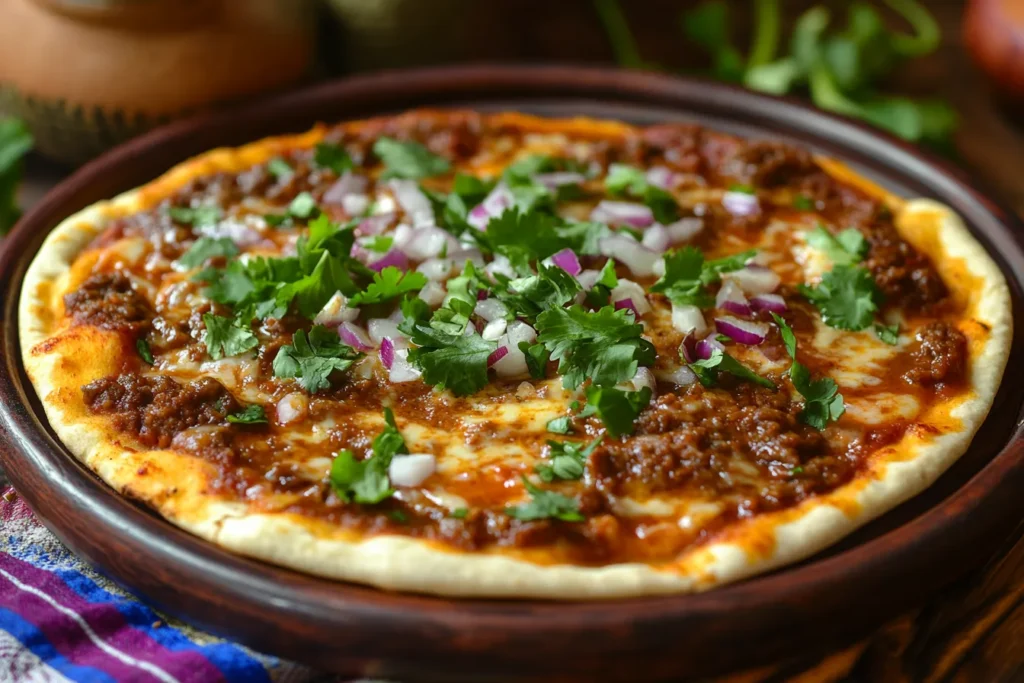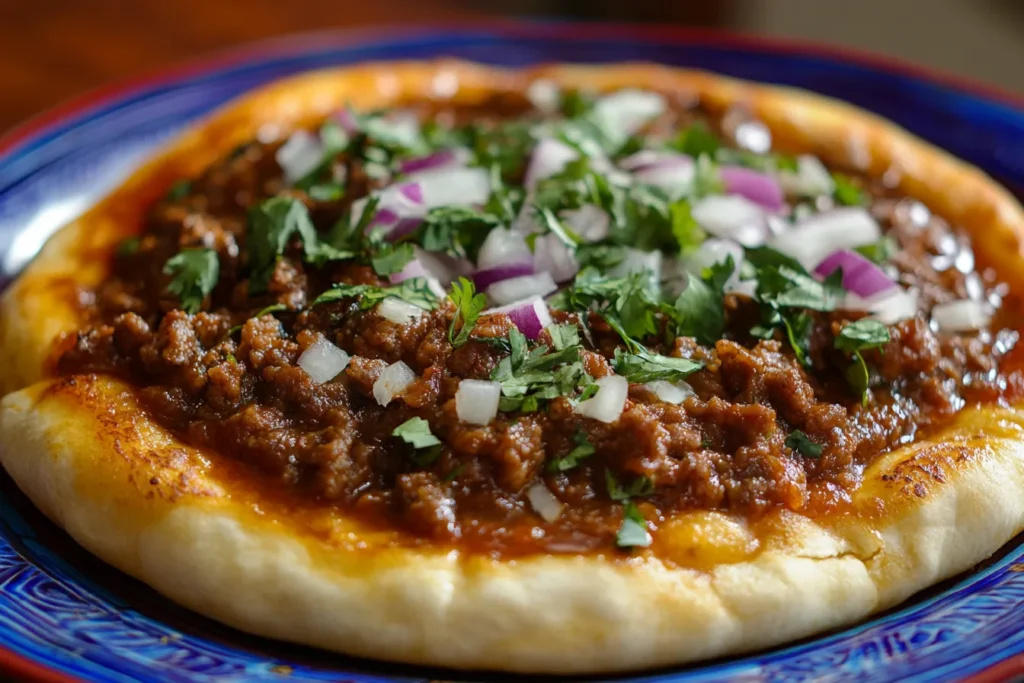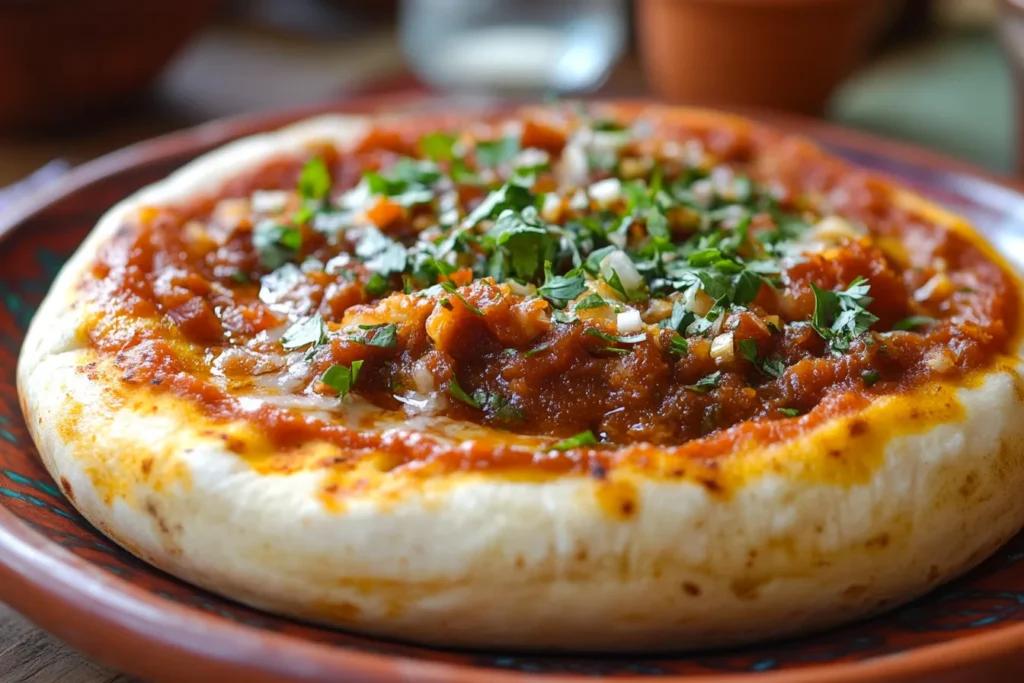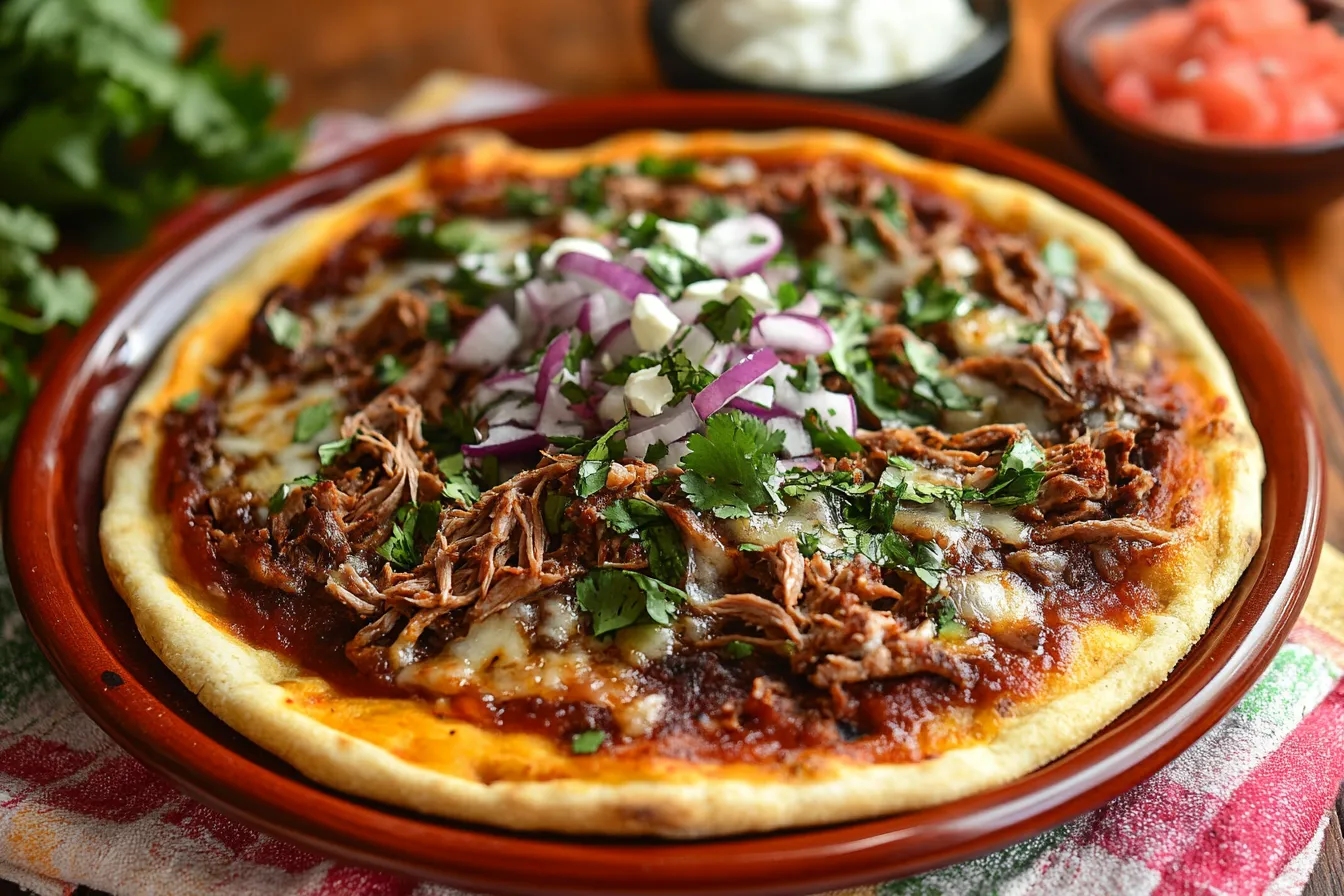Have you ever stared at a menu, torn between indulging in cheesy, satisfying pizza or diving into the rich, bold flavors of Mexican birria? Why choose when you can have the best of both worlds? Pizza Birria is here to solve the eternal food dilemma, combining the comfort of pizza with the mouthwatering goodness of tender birria beef, zesty consommé, and fresh toppings. It’s the ultimate answer to those nights when you want something exciting yet familiar, a dish that feels like a celebration of all your favorite flavors in one bite. Trust me—you’re about to meet your new favorite dinner obsession!
List Of Contents
1. Introduction to Traditional Italian Pizza Flour
When you think of traditional Italian pizza, the first image that likely comes to mind is a beautifully charred crust, light yet chewy, topped with minimal but fresh ingredients. This masterpiece isn’t just the result of good toppings or technique—it starts with the right flour. In Italy, flour plays a foundational role in pizza making, especially for Neapolitan and Roman-style pizzas. The type of flour used can significantly influence the texture, flavor, and overall experience of the pizza.
Italian pizza has been globally celebrated for centuries, but the secret to its perfection lies in a type of finely milled flour called “00 flour.” This special flour is at the core of Italy’s pizza tradition and sets it apart from other styles of pizza across the globe. Check out more recipes here.

1.1 Brief History of Italian Pizza Flour
Modern pizza traces its roots back to 18th-century Naples, Italy. It began as a humble meal for the working class, crafted from basic ingredients like water, flour, yeast, and salt. The quality of flour was crucial even back then, as it determined how long the dough could ferment and how well it baked in wood-fired ovens. Italian millers, over time, perfected the art of grinding wheat to a finer consistency, creating the renowned “00” flour.
“00” flour became a staple for traditional Neapolitan pizza, a style recognized as a UNESCO intangible heritage of humanity. This flour holds a special place in Italian culinary tradition for its exceptional consistency and its ability to create soft, elastic dough.
1.2 Importance of Flour in Traditional Pizza Making
Flour is more than just a binding ingredient in pizza dough—it’s the foundation that gives pizza its unique texture. Italian pizza makers, or pizzaiolos, firmly believe that choosing the right flour is crucial to the success of a pizza. For instance:
- The flour determines how the dough ferments and develops gluten.
- It plays a key role in determining whether the crust turns out chewy or crispy.
- Using high-quality flour allows the dough to endure the intense heat of traditional wood-fired ovens.
In Italy, the selection of flour is not random—it’s a deliberate choice deeply rooted in tradition and culinary expertise.
1.3 What Makes Italian Pizza Unique?
Italian pizza is iconic because of its simplicity, precision, and emphasis on quality ingredients. Unlike pizzas in many parts of the world that emphasize heavy toppings, Italian pizza is all about balance—a light, airy crust topped with fresh tomatoes, mozzarella, and a drizzle of olive oil. The secret to achieving this perfect crust lies in the flour.
Unlike all-purpose or bread flour used in other regions, Italian “00” flour is finely ground, producing a softer, more elastic dough. This makes it ideal for achieving a light and airy crust without sacrificing chewiness. Italian pizza flour is designed to perform exceptionally well in high-temperature ovens, ensuring the crust bakes evenly and rapidly. Check out more recipes here.
2. The Role of “00 Flour” in Authentic Italian Pizza
2.1 What is “00” Flour?
“00” flour (pronounced as “double zero”) is a finely milled wheat flour that originates from Italy. Flour is categorized by its grind size, with “00” representing the finest grind available. In Italy, flour is classified into four main types depending on the amount of bran and germ removed during the milling process:
- Type 00 (most refined)
- Type 0
- Type 1
- Type 2 (least refined)
“00” flour has an ultra-fine, powder-like texture, which makes it ideal for crafting pizza dough. It’s typically made from soft wheat and contains a moderate protein content, usually between 11-12%. This balance allows it to develop a strong gluten structure while maintaining a light, delicate feel.
2.2 Why is “00” Flour Preferred in Italy?
There’s a reason why “00 flour” is synonymous with Italian pizza. Its fine texture allows it to absorb water efficiently, leading to an elastic, smooth dough that’s easy to stretch without tearing. Italian pizzaiolos favor this flour for several reasons:
- High Gluten Development: Despite its fine texture, “00” flour contains enough protein to build a strong gluten structure, resulting in dough that is both elastic and durable.
- High-Temperature Baking: “00” flour can withstand the intense heat of wood-fired ovens (around 900°F/482°C), ensuring the crust rises quickly and gets that signature charred edge.
- Soft Texture: The fine milling ensures there’s no gritty or coarse texture in the finished pizza.
Neapolitan pizza, in particular, relies heavily on “00” flour because of its ability to create the ideal balance between a soft interior and a crispy exterior.
2.3 Characteristics of “00” Flour: Texture, Protein, and Gluten Content
To understand why “00” flour is perfect for pizza, let’s break down its key characteristics:
- Texture: Ultra-fine, almost like talcum powder. This allows for a smoother dough and easier kneading.
- Protein Content: Ranges from 11-12%, which is moderate compared to bread flour. It’s enough to produce strong gluten for elasticity without making the dough overly tough.
- Gluten Development: When properly kneaded, “00” flour develops a gluten network that traps air during fermentation. This results in a light, airy crust.
The combination of these properties ensures that Italian pizzas made with “00” flour are not only authentic but also consistent in quality. Check out more recipes here.
3. Comparing “00” Flour to Other Types of Flour
While “00” flour is ideal for traditional Italian pizza, it’s essential to understand how it differs from other types of flour.
3.1 All-Purpose Flour vs. “00” Flour
- All-Purpose Flour: Widely available, it’s a versatile flour with a protein content of around 10-12%. However, it is coarser than “00” flour, meaning it doesn’t yield the same smooth dough or airy crust.
- “00” Flour: Finer grind, higher gluten development, and better hydration make it superior for pizza dough.
If you’re aiming for an authentic Italian pizza crust, “00” flour will always deliver better results compared to all-purpose flour.
3.2 Bread Flour vs. “00” Flour
- Bread Flour: Contains a higher protein content (12-14%), which creates a chewier crust. While it’s excellent for thicker, chewy pizzas, it’s not ideal for Neapolitan-style pizza.
- “00” Flour: Strikes a balance between chewiness and softness, making it perfect for thin, crispy pizzas.
Bread flour tends to make the dough tougher and harder to stretch, which is why Italian pizzaiolos prefer “00” flour for its elasticity. Check out more recipes here.
3.3 Whole Wheat Flour in Italian Pizza: Is It Traditional?
While whole wheat flour is healthy, it’s not traditional in authentic Italian pizza. Whole wheat flour contains bran and germ, which affect the texture and flavor. The higher fiber content makes the dough denser and less elastic.
Traditional Italian pizzas prioritize a light and airy crust, which is why “00” flour remains the preferred choice.
4. Types of Pizza and Flour Used

4.1 Neapolitan Pizza and “00” Flour
Neapolitan pizza is perhaps the most iconic Italian pizza style, known for its thin, tender crust and signature charred bubbles. This style is deeply rooted in tradition, with strict guidelines set by the Associazione Verace Pizza Napoletana (AVPN) for authenticity.
The AVPN requires that Neapolitan pizza be made with:
- Type “00” flour
- Water
- Salt
- Fresh yeast
The dough must be hand-kneaded, fermented for at least 8-24 hours, and baked in a wood-fired oven at approximately 900°F (482°C).
Why is “00” flour ideal for Neapolitan pizza?
- It creates a dough that stretches easily without tearing.
- The fine grind ensures a smooth, airy interior and a delicate yet chewy bite.
- It supports rapid cooking at high temperatures, resulting in a slightly crispy crust with a soft interior.
Neapolitan pizza wouldn’t be the same without the elasticity and smoothness that “00” flour provides.
4.2 Roman-Style Pizza: A Different Flour Approach?
While Neapolitan pizza focuses on a soft, tender crust, Roman-style pizza offers a crunchier texture. There are two main styles of Roman pizza:
- Pizza al Taglio (pizza by the slice): Baked in rectangular trays, often made with bread flour or Type 0 flour to achieve a crisp, sturdy crust.
- Pizza Tonda Romana: A thin, round pizza with a very crunchy base. This style uses flour with slightly higher protein content to achieve the desired texture.
Although “00” flour can be used for Roman pizza, many pizzaiolos prefer flours with slightly more gluten strength to create a sturdier, more resilient crust. Check out more recipes here.
4.3 Alternative Flours: Semolina, Durum Wheat, and Whole Wheat
While “00” flour remains the gold standard, alternative flours are sometimes used in Italian pizza making, especially for regional variations.
- Semolina Flour: Made from durum wheat, it has a coarse texture and is often used in Sicilian pizza for a thicker, chewier crust.
- Durum Wheat Flour: Higher in protein, it adds a slightly nutty flavor and is sometimes blended with “00” flour.
- Whole Wheat Flour: Though not traditional, it’s gaining popularity for its nutritional value. However, it results in a denser, less elastic dough compared to “00” flour.
While these flours can add variety, authentic Italian pizza remains tied to the qualities of “00” flour.
5. Protein Content: Why It Matters for Italian Pizza Flour
5.1 Understanding Gluten Development
Protein content in flour is directly related to gluten development. Gluten, a combination of two proteins (glutenin and gliadin), is what gives pizza dough its elasticity and structure.
When flour is mixed with water and kneaded, gluten forms a network that traps air during fermentation. This network allows the dough to rise and develop a light, airy texture.
- Low-protein flours: Create softer, more delicate doughs (e.g., cake flour).
- High-protein flours: Produce stronger gluten networks for chewy, dense doughs (e.g., bread flour).
“00” flour strikes the perfect balance with a moderate protein content (11-12%). This allows for excellent gluten development without making the dough tough or overly elastic.
5.2 How Protein Content Affects Pizza Texture
The protein content of flour influences the final texture of the pizza crust:
- Low Protein (8-10%): Results in a very soft crust with minimal chewiness.
- Medium Protein (11-12%): Ideal for Italian pizza, providing a balance of softness and chewiness.
- High Protein (12-14%): Creates a chewier, more elastic crust, better suited for bread-style pizzas.
Italian “00” flour, with its medium protein content, delivers a crust that is:
- Light and airy on the inside
- Slightly crispy on the outside
- Perfectly balanced for thin pizzas
5.3 Achieving a Crispy or Chewy Crust
To adjust texture, pizzaiolos often play with factors like:
- Hydration levels: Higher water content creates a lighter, airier crust.
- Baking temperature: Higher temperatures produce a crispier crust.
- Fermentation time: Longer fermentation develops more flavor and structure.
By starting with “00” flour, Italian pizza makers can fine-tune these variables to achieve the ideal crust—whether it’s soft, crispy, or chewy.
6. How to Source Authentic “00” Flour
Finding authentic “00” flour is essential for recreating traditional Italian pizza at home. Fortunately, several Italian brands are widely recognized for their quality.
6.1 Italian Brands: Caputo, Molino Grassi, and More
The most trusted Italian flour brands include:
- Caputo: Often regarded as the “gold standard” of pizza flour, Caputo’s Pizzeria and Chef’s Flour varieties are ideal for making authentic Neapolitan-style pizza.
- Molino Grassi: Another top-quality Italian brand offering finely milled “00” flour.
- Antimo Caputo: Offers organic and specialty flours designed for high-temperature baking.
These brands are renowned for their consistency, fine milling, and ideal protein content, making them the go-to choice for pizzaiolos worldwide.
6.2 Where to Buy Authentic Italian Flour: Online and Local Stores
You can source “00” flour from:
- Online Retailers: Websites like Amazon and specialty food shops offer a range of Italian flours.
- Italian Groceries: Local Italian markets often stock authentic “00” flour brands.
- Specialty Cooking Stores: Look for flour labeled as “Tipo 00” to ensure authenticity.
6.3 Recognizing Genuine Italian Flour in the Market
To identify authentic Italian flour:
- Look for “Tipo 00” on the packaging.
- Check for certified Italian brands like Caputo or Molino Grassi.
- Verify the protein content (11-12%) for pizza-specific flours.
By sourcing high-quality Italian flour, you can replicate the flavors and textures of authentic Italian pizza right in your kitchen.
7. Tips for Using “00” Flour in Homemade Pizza
Creating authentic Italian pizza at home can seem intimidating, but with “00” flour and the right techniques, you can achieve a crust that rivals those from Italian pizzerias. Below are essential tips for using this flour to make the perfect homemade pizza.

7.1 How to Mix and Knead “00” Flour Dough
The process of mixing and kneading is critical when working with “00” flour. Its fine texture allows for smooth dough formation, but proper technique ensures ideal gluten development.
- Mixing: Combine “00” flour with water, yeast, and salt. Avoid overmixing at this stage.
- Resting (Autolyse): Let the mixture rest for about 20-30 minutes. This step allows the flour to absorb water and begin gluten formation.
- Kneading: Use a stretch-and-fold technique instead of aggressive kneading. The goal is to develop elasticity without tearing the dough.
Pro Tip: Knead until the dough is smooth, elastic, and no longer sticky. If kneading by hand, this typically takes 8-10 minutes.
7.2 Hydration Levels: The Secret to Great Pizza Dough
Hydration is the proportion of water to flour in the dough. Higher hydration creates a lighter, airier crust. With “00” flour, aim for:
- 60-65% Hydration: Best for beginners, as it’s easier to handle.
- 70%+ Hydration: Creates an airy, bubbly crust but requires practice.
The absorbency of “00” flour ensures that higher hydration doesn’t make the dough overly sticky. Gradually adjust the water levels to achieve the ideal balance.
7.3 Adjusting “00” Flour for Home Ovens
Traditional Neapolitan pizza is baked in wood-fired ovens at 900°F (482°C), a temperature most home ovens can’t reach. To replicate similar results:
- Preheat your oven at the highest temperature possible (usually 500-550°F).
- Use a pizza stone or steel plate to simulate the heat retention of a wood-fired oven. Position the stone on the bottom rack to ensure even cooking.
- Bake for a shorter time (6-8 minutes) to avoid drying out the crust.
Pro Tip: Lightly dust the surface with semolina to prevent sticking and achieve a crispy base.
8. The Science Behind Perfect Italian Pizza Dough
The perfection of Italian pizza isn’t accidental—it’s a result of time, temperature, and the right flour. Understanding the science behind dough fermentation and baking will elevate your pizza-making skills.
8.1 Fermentation and Rising Time
Fermentation develops the flavor and structure of pizza dough. With “00” flour:
- Use cold fermentation (refrigerating the dough) for 24-48 hours. This process slows yeast activity, giving time for complex flavors to develop.
- Allow the dough to rest at room temperature for 1-2 hours before baking to make it easier to stretch.
The gluten network created with “00” flour during fermentation traps air bubbles, resulting in a light, airy crust.
8.2 Temperature: Why Wood-Fired Ovens Matter
The extreme heat of wood-fired ovens (900°F/482°C) is crucial for creating the:
- Signature leopard-spotting (charred bubbles) on the crust.
- Soft, slightly chewy interior with a crisp exterior.
“00” flour is specially designed for these conditions, as its gluten structure can handle rapid expansion without tearing.
8.3 Achieving the Ideal Crust with “00” Flour
The perfect pizza crust is the result of:
- Proper hydration (aim for 60-70%).
- Slow fermentation for flavor.
- High-temperature baking for a quick rise and crispy edges.
By using “00” flour, you’re already setting yourself up for success. The fine texture and moderate protein content ensure that the dough rises beautifully and bakes evenly.
9. Substitutes for “00” Flour: Are They Viable?
While “00” flour is ideal, it’s not always readily available. Below are alternatives and how they compare.
9.1 Best Alternatives for “00” Flour
If you can’t find “00” flour, consider these substitutes:
- All-Purpose Flour: With a similar protein content, it works well for thin-crust pizza but lacks the fine texture of “00” flour.
- Bread Flour: Higher in protein (12-14%), it creates a chewier crust with more gluten strength. Ideal for Roman-style pizza.
- Whole Wheat Flour: Nutritious but denser, it works best when mixed with all-purpose or bread flour to maintain a light texture.
9.2 Adjusting Recipes When Substituting Flour
When using substitutes:
- Slightly increase the hydration, as “00” flour absorbs water more effectively.
- Knead for a longer time when using coarser flours, such as bread flour, to properly develop gluten.
- Combine whole wheat flour with “00” or all-purpose flour to achieve a balanced texture.
9.3 Common Mistakes When Using Alternative Flours
Avoid these pitfalls:
- Using too much flour during kneading—it dries out the dough.
- Skipping fermentation—rushed dough lacks flavor.
- Under-baking—alternative flours often require a bit more time to cook through.
While substitutes can work, nothing truly matches the lightness and elasticity of authentic “00” flour.
10. Conclusion: Why “00” Flour Defines Traditional Italian Pizza
10.1 Summary of Key Points
The type of flour used in pizza dough determines the texture, flavor, and authenticity of the final product. Italian “00” flour stands out for its:
- Ultra-fine texture
- Moderate protein content for balanced gluten development
- Ability to create a light, airy crust perfect for high-temperature baking
10.2 Why Authenticity Matters in Italian Cuisine
Authenticity is central to Italian culinary tradition. Using the right flour honors centuries of craftsmanship and cultural heritage. Whether it’s Neapolitan pizza or Roman-style pizza, the foundation remains the same—high-quality flour like “00”.
10.3 Final Thoughts on Choosing the Right Flour
While alternatives like all-purpose or bread flour can work, “00” flour is the gold standard for achieving a pizza crust that’s:
- Soft and elastic
- Light and airy
- Crisp yet tender
For anyone passionate about making authentic Italian pizza, sourcing and using “00” flour is a worthwhile investment that guarantees delicious results every time.
FAQs About Flour for Traditional Italian Pizza
- What is “00” flour, and why is it special?
“00” flour is an ultra-finely milled Italian flour ideal for pizza due to its fine texture and perfect gluten balance. - Can I use all-purpose flour for Italian pizza?
Yes, but the results won’t be as light and elastic as with “00” flour. - What’s the difference between “00” flour and bread flour?
Bread flour has higher protein, creating a chewier crust, while “00” flour produces a more delicate texture. - Where can I buy “00” flour?
Look for brands like Caputo or Molino Grassi in Italian markets or online. - Does “00” flour work in home ovens?
Yes, but use a pizza stone and bake at the highest temperature possible. - Is semolina flour good for pizza?
Yes, it’s often used in Sicilian pizza for a chewier crust. - Can I mix “00” flour with other flours?
Absolutely! Mixing with whole wheat or bread flour can create unique textures. - How does protein content affect pizzadough?
Protein determines gluten development, which influences the chewiness and elasticity of the crust. - What hydration level works best with “00” flour?
Aim for 60-70% hydration for a light, airy dough. - Is “00” flour only for pizza?
No, it’s also great for pasta and bread due to its fine consistency.
